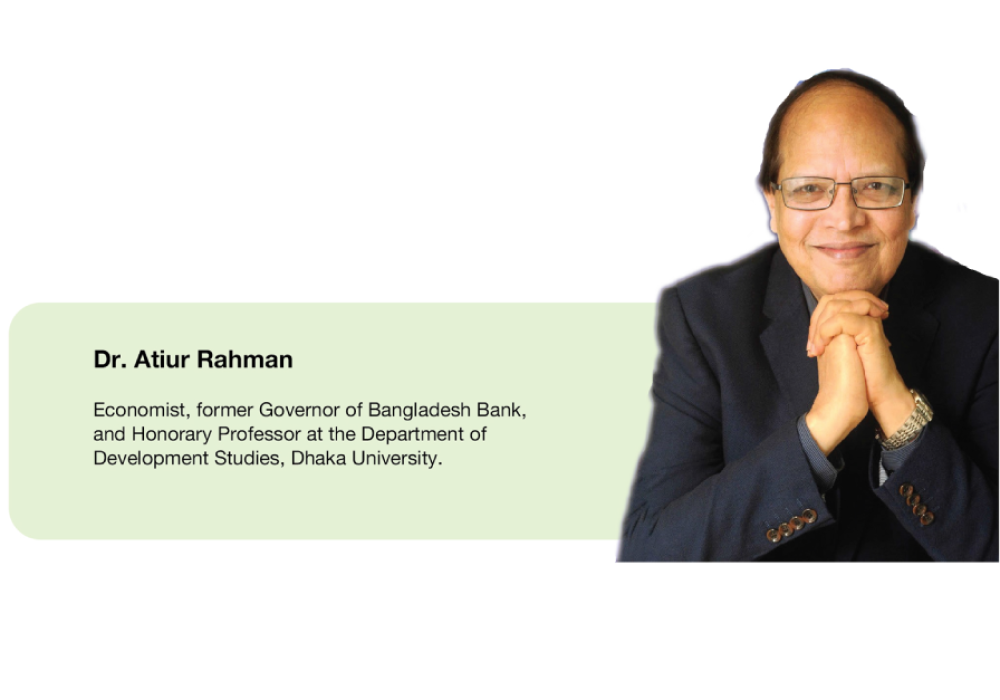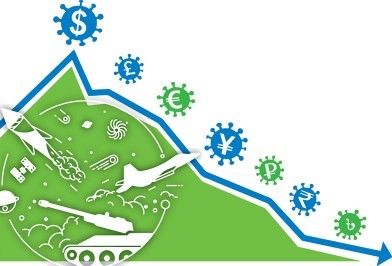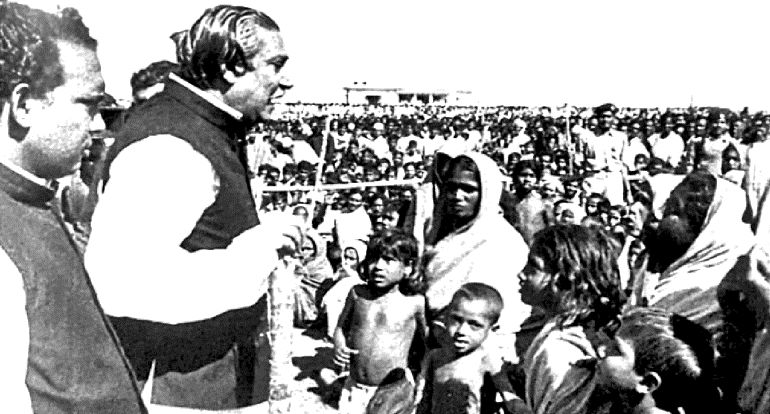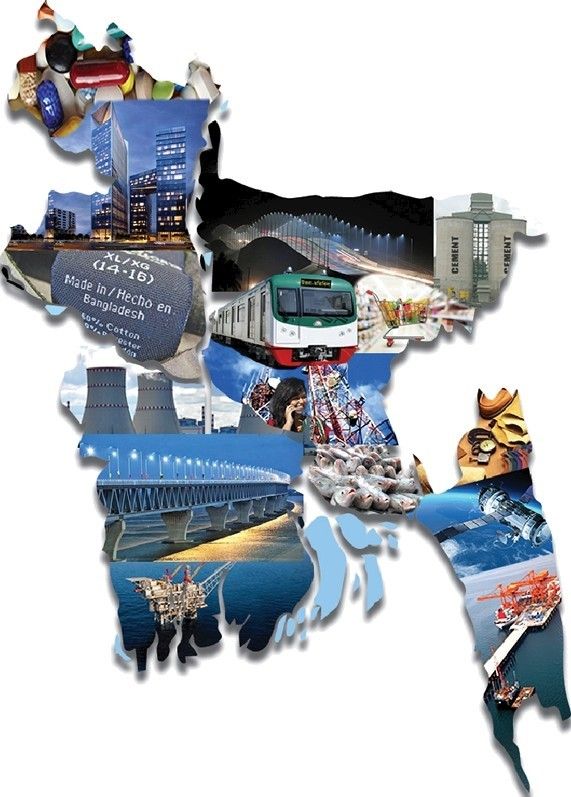![]() ficci admin
ficci admin
![]() August 28, 2023
August 28, 2023
![]() (0) Comment
(0) Comment

![]() ficci admin
ficci admin
![]() August 28, 2023
August 28, 2023
![]() (0) Comment
(0) Comment
1. Global and Local Context
 The ongoing global financial turmoil in the wake of the acute economic crisis precipitated by the fallouts of COVID-19 and the subsequent Ukraine war invited nonconventional economic management, including sudden, persistent tightening of monetary policy in the West to fight unprecedented inflation. The rising policy rate in the US has already led to the collapse of a few banks, including one of the largest banks, Silicon Valley Bank. The European banking sector has also been under attack. Credit Suisse has been rescued by merging it with UBS. A leading German bank (DB) is also under enormous pressure. Unless the global financial regulatory infrastructure is quickly reformed, waves of economic turmoil will also hit the shores of the economic systems of emerging economies. The best option for the countries like Bangladesh will be to seek refuge in their domestic economy, which survived quite well during earlier crises. Its down-to-earth econom- ic management strategy always tried to touch the ground and strengthen the real economy. Of course, it also followed innovative monetary and fiscal policies to keep the bottom of the social pyramid stronger through its various inclusive financing policies. This may be challenging as the Bangladesh economy is much more globalized, and its financial sector remains highly opaque and elite driven. Yet, we must try hard to seek strength from the heritage of our inclusive economic management style, which we owned from our struggle for economic freedom led by our Father of the Nation Bangabandhu Sheikh Mujibur Rahman. He crystallized his more profound understand- ing of the equitable economic framework in the campaign for realizing the Six-Points political agenda against the neo-colonial rule of West Pakistan, which became the bedrock of his ultimate onslaught against the ruling elites of Pakistan. The result was a war of liberation, leading to the birth of Bangladesh in 1971. Indeed, this historical link to the 1971 war gave birth to a spirited campaign for economic freedom, again led by Bangabandhu, which provided the base for an all-embracing economic management strategy.
The ongoing global financial turmoil in the wake of the acute economic crisis precipitated by the fallouts of COVID-19 and the subsequent Ukraine war invited nonconventional economic management, including sudden, persistent tightening of monetary policy in the West to fight unprecedented inflation. The rising policy rate in the US has already led to the collapse of a few banks, including one of the largest banks, Silicon Valley Bank. The European banking sector has also been under attack. Credit Suisse has been rescued by merging it with UBS. A leading German bank (DB) is also under enormous pressure. Unless the global financial regulatory infrastructure is quickly reformed, waves of economic turmoil will also hit the shores of the economic systems of emerging economies. The best option for the countries like Bangladesh will be to seek refuge in their domestic economy, which survived quite well during earlier crises. Its down-to-earth econom- ic management strategy always tried to touch the ground and strengthen the real economy. Of course, it also followed innovative monetary and fiscal policies to keep the bottom of the social pyramid stronger through its various inclusive financing policies. This may be challenging as the Bangladesh economy is much more globalized, and its financial sector remains highly opaque and elite driven. Yet, we must try hard to seek strength from the heritage of our inclusive economic management style, which we owned from our struggle for economic freedom led by our Father of the Nation Bangabandhu Sheikh Mujibur Rahman. He crystallized his more profound understand- ing of the equitable economic framework in the campaign for realizing the Six-Points political agenda against the neo-colonial rule of West Pakistan, which became the bedrock of his ultimate onslaught against the ruling elites of Pakistan. The result was a war of liberation, leading to the birth of Bangladesh in 1971. Indeed, this historical link to the 1971 war gave birth to a spirited campaign for economic freedom, again led by Bangabandhu, which provided the base for an all-embracing economic management strategy.
2. Pro People Development : A Comprehensive Planned Camping
Bangabandhu developed this strategy with support from reputed economists led by Professor Nurul Islam, whom he chose as the first Deputy Chair of the Planning Commission to draw the contours of a long-term planned develop- ment of Bangladesh where ordinary people, including peasants, workers, and small and medium entrepreneurs were prioritized to get the benefits first. Professors Rehman Sobhan, Mosharraf Hossain, and Anisur Rahman joined the planning commission as members and many highly credible economists and professionals to design the first five-year plan for Bangladesh. The then Finance Minister, who was also the Prime Minister of the war-time govern- ment which Bangabandhu headed (in absentia), Mr. Tajuddin Ahmed, provided the best moral support to this economic management team. Later, Mr. M Syeduzzaman joined the team as Secretary of the commission and economic affairs and became the bridge between the political leadership and the economic management team. Despite many tensions arising from the tug of war between the veteran bureaucrats and the high-profile planners, the planning commission could prepare an excellent document for reconstruction and subsequent inclusive development of Bangladesh with the needed political blessings from Bangabandhu. Although this plan could not be fully implemented due to the brutal killing of Bangabandhu in August 1975, the primary source of inspiration for this farsighted document, it remains the brightest embodiment of planned economic development focused on the upliftment of the lots of the downtrodden. The planners, too, were deeply soaked in the exploration of expectations of the freedom-loving people of Bangladesh as they risked their lives in joining the war of liberation. Some worked closely with the government in exile to prepare the planning-related draft documents that proved vital in designing economic reconstruction policies.

Bangabandhu, with enthusiastic support from the Planning Commission, started a concerted campaign for inclusive development. The First Five Year Plan (1973-78), drawing its inspiration from the pledges of the constitu- tion, which was formulated in the record time of only nine months, provided a well-thought-out economic strategy focusing on how to rejuvenate the economy along with providing social justice for the many to remove the social disparity which was at the heart of the liberation struggle of Bangladesh.
Nature, too, was very unkind to Bangladesh in its formative days as floods and cyclones persisted. Yet he never lost hope. Instead, he encouraged deeper social mobilization among his people to concentrate on achieving self-re- liance in food production, reducing the birth rate by adopting family planning and welfare measures, and, of course, robust support for primary education. He went for limited land reforms, modernization and diversification of agricul- ture, rural credit, and co-operatives to enhance food production. His support for public sector-led industrialization was fait accompli as all entrepreneurs from West Pakistan suddenly left Bangladesh, leaving no other option but to nationalize these enterprises to keep them operational. Again, this entailed a substantial economic management challenge. And he was well advised by the Planning Commission to mobilize the best professional managers to run these enterprises. And, of course, he went by their advice. Despite some flaws in running these enterprises, Bangladesh could keep the industrial output at a reasonable level along with the employment of the workers who were so supportive of an equitable Bangladesh. That did not mean Bangaband- hu was against the growth of the private sector. He raised the ceiling of private investment to 30 million Taka in 1975 from the earlier set amount of 2.5 million Taka. Also, he allowed the privatization of hundreds of smaller industrial enterprises that were earlier bundled as abandoned units and run by public management. But unfortunately, his experimentation with the mixed economy could not be sustained after his brutal demise. The new regime went for wholesale denational- ization of many of these units. It encouraged private sector capture of the state properties without caring for the essen- tial spirit of reducing socio-economic disparity as envisaged by the architects of independent Bangladesh.
And he was well advised by the Planning Commission to mobilize the best professional managers to run these enterprises. And, of course, he went by their advice. Despite some flaws in running these enterprises, Bangladesh could keep the industrial output at a reasonable level along with the employment of the workers who were so supportive of an equitable Bangladesh. That did not mean Bangaband- hu was against the growth of the private sector. He raised the ceiling of private investment to 30 million Taka in 1975 from the earlier set amount of 2.5 million Taka. Also, he allowed the privatization of hundreds of smaller industrial enterprises that were earlier bundled as abandoned units and run by public management. But unfortunately, his experimentation with the mixed economy could not be sustained after his brutal demise. The new regime went for wholesale denational- ization of many of these units. It encouraged private sector capture of the state properties without caring for the essen- tial spirit of reducing socio-economic disparity as envisaged by the architects of independent Bangladesh.
3. Back To Inclusive Development Strategy
After a prolonged struggle for democratization, the country is now back to the contour of an inclusive development strategy. However, despite the greater emphasis on a socially responsible development strategy with prioritization for agriculture, small and medium enterprises, and a higher level of financial support for social security, the econo- my is now definitely private sector led (Rahman, 2021). Nothing is wrong if the business elites remain ethical and focused on public interests. Most contemporary business elites seek public patronage without being transparent and socially responsible. The phenomenal growth in non-performing loans and frequent violations of regulatory compulsions indicate that there may have been some captures of the regulators and policymakers. On the contrary, many genuine good entrepreneurs are hard-working and socially responsible. Several have transformed into green entrepreneurs and are contributing significantly to sustainable development. Under the dynamic leadership of the present Prime Minister, the country has been witnessing phenomenal growth in almost all sectors of the economy. Her support for agriculture is well known. Despite the current economic crisis, Bangladesh continues to provide financial support to agriculture, including greater research and development investment (Razzaque, 2021). As a result, the productivity of agriculture has been enhanced along with the addition of non-cereal sub-sectors like the production of fish, chicken, livestock, vegetables, fruits, etc. Many young, educated entrepreneurs are now embrac- ing modern agriculture as their profession. Digitization and inclusive financing aid them in getting into new areas of agricultural development. The growth of small and medium enterprises, thanks to the early development of microfi- nance industry in Bangladesh and the great regulatory support provided by the developmental central bank of Bangladesh. As a result, Bangladesh coped so well during the last Global Financial Crisis (2009 onwards) and continued its inclusive growth journey consistently.

 Defying the pandemics and the Ukraine war, Bangladesh has been growing 6.25 percent over the last 13-14 years. There was a sudden dip in growth to 3.75% in 2020 due to covid-19, still better than most Asian countries. But it quickly recovered from that downfall and has demonstrated its strength today. Had there been no Ukraine war, Bangladesh would have grown near double digits by now. With the launching of the Padma bridge, which has connected 21 Southern districts of Bangladesh with the mainstream economy of the capital and its adjoining industrial hubs, an additional growth rate of 1.2% of GDP is on the card. When the Metro rail, Elevated Express Way, Bangabandhu Tunnel under the Karnafuli river, and the deep seaport in Matarbari are fully operational in a couple of years, Bangla- desh will certainly register double-digit growth. Add to this growth potential of a hundred special economic zones, ten already in opera- tion. In other words, over 70% of the growth since Bangladesh’s inception was achieved during the last fourteen years. So is the case with other macroeconomic indicators. 61% of the export growth, 69% of the import growth, and 60% of the remittances growth has taken place during the said period. The reserve grew about 87% of the total during this period (Finance Division, GoB, 2022).
Defying the pandemics and the Ukraine war, Bangladesh has been growing 6.25 percent over the last 13-14 years. There was a sudden dip in growth to 3.75% in 2020 due to covid-19, still better than most Asian countries. But it quickly recovered from that downfall and has demonstrated its strength today. Had there been no Ukraine war, Bangladesh would have grown near double digits by now. With the launching of the Padma bridge, which has connected 21 Southern districts of Bangladesh with the mainstream economy of the capital and its adjoining industrial hubs, an additional growth rate of 1.2% of GDP is on the card. When the Metro rail, Elevated Express Way, Bangabandhu Tunnel under the Karnafuli river, and the deep seaport in Matarbari are fully operational in a couple of years, Bangla- desh will certainly register double-digit growth. Add to this growth potential of a hundred special economic zones, ten already in opera- tion. In other words, over 70% of the growth since Bangladesh’s inception was achieved during the last fourteen years. So is the case with other macroeconomic indicators. 61% of the export growth, 69% of the import growth, and 60% of the remittances growth has taken place during the said period. The reserve grew about 87% of the total during this period (Finance Division, GoB, 2022).

According to the soon-to-be-published Household Income and Expenditure Survey report, the economy has recovered well, and the national poverty level may have been reduced to 16-17 percent. The growth of middle and advanced consumers and the number of students joining tertiary educational institutions, both public and private, remain very high (will be 36% by 2026) with a higher level of disposable income (Gomes and Raad, 2022). Suppose we can withstand the waves of a global financial crisis originating from the bank failures of the West. In that case, Bangladesh is well poised to mimic the growth trajectory of South-East Asian economies riding on the possibility of achieving a per capita GDP of 4,000 USD by 2026. Nothing to be complacent about these achievements as the world economy is yet to be stabilized. The spillover effects of the global banking crisis can be real. The climate challenges can be ravaging. The problems of governance failures, market failures, growing frustrations over corrup- tion, low quality of education, lack of growth in labor force skills, and high out-of-pocket health expenditure can be big brakes on our otherwise fantastic growth journey. To remain on board and do more to accelerate further our growth momentum, we need to focus more on the quality of economic policymaking and its apt implementation.
4. The Challenging of Economic Management
|
4.1 The overzealous focus on faster growth has led to the undertaking of many development projects, includ- ing some mega projects with external funding support. Even if the implementation of some of these projects may have been slowed down or pruned, the fact remains that there is still a severe problem of mobilizing enough resources to continue the earlier pace of development. In particular, the devaluation of the Bangladesh Taka against the US dollar has enhanced the cost of most of these projects by about 25-27 percent in domestic currency. Moreover, the local development expenditure also has some foreign exchange implications as it must pay for imported inputs. Had the feasibility study by the economic management team been done more profes- sionally, incorporating these challenges, the resource mismatch would have been manageable. Therefore, this calls for a more in-depth feasibility study for any develop- ment project taking note of changing economic architec- ture, both local and global.
4.2 There needs to be more coordination in our econom- ic policy-making process. For example, the budget is implemented by various ministries and divisions. The Ministry of Finance, which prepares the budget, needs more effective control over these implementing agents. This lack of coordination can lead to poor quality of feasibility study, showing weaknesses in project prepara- tion.
4.3 Controlling inflation is the central bank's number one headache. Almost all central banks, particularly of the developed countries, are steadfastly tightening their monetary policies. Even our neighboring central bank, RBI, is following the same path. Other central banks of developing countries are not shying away from this policy intervention either. Their focus has been on raising the policy rate consistently. They have been able to reduce inflation by squeezing the aggregate demand. Bangladesh's financial inclusion drive since 2009 has helped the banking sector to remain stable despite many challenges arising from low quality of governance leading to rising insider credit and non-performing assets. While some banks are facing the challenge of lack of liquidity due to governance-related weaknesses, the fact remains that Bangladesh's banking sector has been able to fortify its stability by not only diversifying the deposit base where more than three million school banking accounts with long-term deposit base but has also been providing credit to farmers, micro, small and medium enterprises. Its wholesale credit to the microfi- nance industry and several refinance lines for the real economy, including a well-run green financing program, has added strength to the developmental banking in Bangladesh. Yet, there is a vast scope for improving the coordination between the regulators and the govern- ment for financial inclusion. Simultaneously, the central bank and the government must work very closely so that the gossip mongers do not get the upper hand in spread- ing the rumors leading to the sudden withdrawal of deposits. |
4.4 We usually prefer firefighting when in crisis. Instead, the economic ministries must go beyond their day-to-day short-term activities and acquire the culture of long-term planning with definite milestones in their roadmaps. Here also, there needs to be more coordina- tion between them. Look at Bangladesh’s recent human tragedies related to the explosion of gas cylinders causing an unstoppable fire. The poor level of coordina- tion between the ministries of industries and works and the city corporation was left bare during those disasters. Here, the economic ministries also had a role in encour- aging these ministries and agencies to go for long-term structural reforms so that similar tragedies don't repeat. The trade bodies also have a role to play in this matter.
4.5 . Lack of necessary information is another critical challenge for better economic management. Most of the development ministries still need to be entirely digitized. Their planning wings still need to be fully digitized. So, they cannot maintain a digital database. Whenever the ministry of planning or finance asks for any information, they need help to retrieve it from their digital archive. Instead, they go for hunting the information physically time and again. This incapacity wastes time and human resources and creates hurdles against the appropriate planning of projects or programs for the relevant agencies. The ministry of finance needs data from the ministry of planning and other implementing agencies. However, they don't have well-trained economists, statisticians, or data managers to respond to the call of the Ministry of Finance, which must deal with internation- al development partners like the IMF and World Bank or ADB.
|
4.6 The culture of all out ‘control’ in our economic management architecture has been crippling our capacity to move forward. We hardly go by the signals of the markets. Instead, we want to solve all our economic problems using our age-old control mechanism. Be it stabilizing the prices of essentials or dollars or any service; we just went for controlling onslaughts. Of course, some interventions may be necessary if there are market failures. The best response will be to augment supplies by providing an extra supply chain (as TCB and the Department of Livestock recently did). Instead, we pursue control mechanisms that further distort markets. Of course, the Competition Commission can devise interventions to break the monopoly or oligopoly by some unscrupulous economic actors. Similarly, we could have done far better in our foreign exchange and interest rates management if we could trust the markets to give adequate signals on what to do. The market-determined solutions in these two critical financial markets could have avoided many of the tensions we have witnessed in the financial sector. This is a challenging area of economic management, and we must rise to the occasion to straighten these anomalies. And this is certain- ly within our reach if we want to kill the foreign exchange speculators and vested quarters engaged in keeping the price of their credit low at the cost of others.
4.7 The level of transparency in economic policymaking, particularly the budget-making process, still needs to be added. Even the parliamentary scrutiny of the proposed budget could be more robust. The quarterly review of the fiscal performance in the parliament is routine without much more profound debates. However, we were impressed by a presentation from the Ministry of Finance when the economists met the finance minister online to give our pre-budget suggestions to the budget makers. This practice has been going on for quite some time. We give suggestions. The ministry officials take notes. But we never learn what happens to the ideas shared during such sessions. This time, it was a different ball game. One of the Ministry of Finance officials gave a succinct presenta- tion of what we said before the last budget and how much they could reflect in their budget and other economic policies. This was encouraging, and we look forward to a rich culture of interactions and transparency in improving the quality of economic management. I can go on adding more such challenges of economic policy making. Let’s now look into the opportunities for improving the economic management architecture.
4.8 During the said meeting with the economists facilitated by the Ministry of Finance, specific policy measures were suggested by the economists and the Finance Ministry representatives led by the honorable Finance Minister himself- committed to duly consider those suggestions while preparing the budget for the next fiscal year (i.e., FY2023-24). To ensure the desired boost in GoB's revenue income, we suggested resorting to Alternative Dispute Resolution (ADR) and any other means necessary to quickly resolve the unrealized huge pile of tax related disputes between the NBR and the large taxpayers. We also urged to ensure fast and effective digitalization of the tax collec- tion process to ensure maximum ease in tax paying. We also reiterated to rationalize the corporate taxes (Bangla- desh has the highest corporate tax rate in South Asia). It has also been inferred by the sector experts that further downward revision of the tax rates for listed companies would incentivize additional number of larger companies to get listed in the capital market, which in turn would increase the tax earnings of the government. While we (the economists) have recommended GoB to go for a contractionary fiscal policy, we believe social sectors (e.g., social security, health, and education) should not be overtly affected by this contraction. Rather, policymakers ought to increase allocations for social security (to bolster existing programs and initiate new ones) to safeguard lower-in- come households from inflationary pressure. Increasing allocations for health could save these households from the high out-of-pocket health expenditure (currently 68%). Similarly prudent investment in education considering the realities of the fourth industrial revolution could better equip the households for suitable employment and economic security. For that matter, there should be significantly more investment in technical education and skills development for ensuring the desired human resources for coping with the challenges of the fourth industrial revolu- tion.
5. The Opportunities
If the policymakers agree that the above challenges are in place, the battle is won. If they want to improve the architecture of policymaking and related implementation, we may provide them with some windows of opportunity.
1. The economic ministries should have both internal and external policy advisers. Individual ministries can invite experts and former policymakers to give advice consistently to the Ministry or Division. To make this effective, there must be in-house economists and data management specialists who will prepare the ground for smooth policy discussions with external advisers. The Japanese ministries regularly take advantage of external experts through creating an advisory council for each of the ministries. Our country has many private and public research institu- tions in various fields of study. In addition, different departments of various universities have well-trained experts. The ministries can undoubtedly pull their services. Also, former officials with a vast pool of acquired knowledge can be utilized for this purpose.
2. We can also learn from success stories in other countries. Japan learned a lot from the West's legal procedures and civil services while going through Meiji Restoration. The reforms they undertook utilizing western knowledge later put Japan in an advantageous position. And that openness is still there in Japanese administrative culture. China has learned a lot from the economic policymaking of Singapore, South Korea, Malaysia, and other Southeast Asian countries that were spotted as hubs of economic miracles. China's initial focus was on low-skilled export-led growth. From there they eventually opened their economy to foreign direct investment. Vietnam later learned from China precisely the same policy innovations. India sent its young government officials to the US and other western countries to learn more about economic and financial negotiations. And we can now see how Indian negotiators are doing so well in various committees of WTO and other global bodies. Currently, India is running the Presidency of G20 with the help of these smart officials and experts from the research institutions, universities, and trade bodies.

As already indicated, Bangladesh Bank has invested a lot in human resource development by sending its officials to various other central banks and research institutions. The research department of Bangladesh Bank benefited from the pulling of well-trained experts from the World Bank, IMF, and foreign universities. Some of them were made Chief Economists of the Bank and contributed hugely to improving the quality of research and monetary policymaking. Bangladesh Bank also acquired the culture of retaining some of the best performing central bankers (e.g., late Allah Malik Kazemi) as advisers to the Governor to take advantage of the legacy of their wealth of knowl- edge and experiences. It also fell back on the knowledge of external experts while developing innovative policies on financial inclusion. Other agencies and ministries can replicate these indigenous success stories of economic management.
5.4. I am happy to see Bangladesh going for the IMF program. This program will not only give foreign exchange support but will also help improve our economic management infrastructure. From my experience as a regulator, I am confident that central banks and finance ministries ought to be developed as knowledge institutions. And IMF can provide the best knowledge inputs in designing better monetary policy and budget if we remain open to the culture of learning from others. Already IMF team has started working closely with the officials of Bangladesh Bank, NBR, Ministry of Finance, and other ministries who will come within the program’s purview. They are exchanging data in formats prepared by the joint team. At the end of the program, I am sure our officials will be better trained as economic managers due to this learning-by-doing exercises.
6. Concluding Remak
The world is changing fast. Our economy has undoubtedly been globalized to a great extent. The ongoing global financial crisis is making policymaking even more difficult now. It is always wise to gather more minds from home and abroad to modernize our policymaking and management tools to respond to global challenges. Of course, we have in our store many success stories as well, particularly in the areas of low-cost solutions in primary health, microfinance, financial inclusion, responding to climate change challenges, women empowerment, participatory budgeting, and developing partnerships between private and public entities. Thanks to these innovative institutions and the entrepreneurial spirit embedded in our society and government, Bangladesh has been doing far better than many of its peers in coping with the challenges of pandemics, the Ukraine war, and the subsequent global econom- ic crisis. These challenges can also become good educators if we play our cards well. Let’s work together for a better economic management architecture defying all challenges.

7. References
1.Finance Division (2022). Bangladesh Economic Review 2022. Ministry of Finance. Government of the People’s Republic of Bangladesh.
2.Gomes, N. D., and Raad, R. A. (2022). Bangladesh Economy at an Inflection Point. CAL Bangladesh. CAL Research.
3.Planning Commission. (1973). The First Fivey Year Plan 1973-78. Planning Commission, Government of the People’s Republic of Bangladesh
4.Rahman, A. (2021). Journey Toward a Sustainable and Inclusive Bangladesh: Amazing Macroeconomic Trans- formation of the Economy. In Alam, Q., Rahman, A., and Islam, S. R. The Economic Development of Bangladesh in the Asian Century Prospects and Perspectives. pp. 11-28. New York: Routledge
5.Razzaque, M. A. (2021, September 18). Bangladesh’s Agro- Revolution. Whiteboard. Retrieved from: https://whiteboardmagazine.com/2514/bangladeshs-agro-revolution.